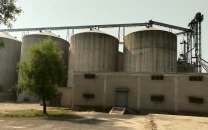1% economic growth in Q1 forecast
Finance Ministry sees dip in monthly remittances as FBR exaggerates tax collection

Pakistan’s economy would expand by around 1% in the first quarter (Q1) of the current fiscal year but remittances would go down to their monthly average of around $2.2 billion, the finance ministry said on Wednesday.
The ministry’s monthly Economic Updates and Outlook report for the month of August also revealed that the Federal Board of Revenue (FBR) exaggerated tax collection by Rs10 billion for the month of July.
The monthly bulletin of the ministry also showed that inflation would remain at its current level and there was less money available for private sector borrowings during the first five weeks of the current fiscal year.
“Given current information, economic activity in Q1 of FY2021 would recover at least around the level observed in Q1 of FY2020”, according to the finance ministry report.
In its previous outlook for the month of July, the ministry had stated that the economy had grown by 0.97% in first (July-September) quarter of last fiscal year. In the last fiscal year, the economy contracted 0.4%, largely because of the spread of the coronavirus pandemic.
The ministry said that the economic recession, following the impact of the Covid-19 pandemic, was coming to the end. Based on high frequency indicators, summarised in the Monthly Economic Indicator (MEI), economic growth resumed in June and July 2020, it added.
The MEI marginally picked to 1.4% in July from 1.3% in June. Based on current economic, fiscal, monetary and exchange rate policies and on the prospects for the international environment, the ministry said, economic activity was expected to rebound strongly within the Q1.
The finance ministry said that recession in industrial output will be tempered in recent months, which is also an indication of economic recovery due to lifting of lockdown throughout the country. The trend would continue in July 2020 and further improvement is expected in coming months.
On the external front, the ministry said that the trade balance on goods and services would converge to the level seen in the first three months of the previous fiscal year and would therefore be manageable in terms of its financing.
The inflation was also expected to stabilise in the first quarter of the current fiscal year based on current information, and in the absence of unexpected shocks or policy measures, at around current levels. The ministry predicted that the inflation would remain in the range of 8.4% to 9.7% in August. In July the reading was 9.3%.
The finance ministry said that in recent months, international oil price tended to recover from recent lows and the dollar-rupee exchange rate had been rising gradually. The rupee further shed its value on Wednesday and traded at Rs168.43 against the greenback in the interbank market.FBR credibilityIn July, the FBR had claimed that it collected Rs300 billion in taxes during the first month of the fiscal year, showing a 6% growth rate. “The FBR tax collection grew by 4.7% to reach Rs 290.5 billion in the month of July, FY2021 against Rs277.3 billion in the comparable period of FY2020”, the report revealed.
The FBR has long been facing credibility crisis and difference in tax collection figures would further dent its trustworthiness in the eyes of the stakeholders.Money SupplyThe report also showed that the total stock of money circulating in economy contracted during first five weeks of the fiscal year. There was less money available for borrowing during the first five weeks of this fiscal year, which meant there was less money available for consumer spending.
During the period – 1st July to 7th August, money supply (M2) witnessed contraction of Rs224.5 billion, showing negative growth of 1.1% compared with contraction of Rs172.8 billion and negative growth of 1% in last year, stated the finance ministry. The contraction in money supply was largely attributed to decline in the Net Domestic Assets (NDA).
Within NDA, net government sector borrowing remained negative and it retired Rs244.3 billion against borrowing of Rs15.2 billion last year. The government had retired Rs435.4 billion to SBP.
The ministry said that the government adhered to its commitment to borrowing from the central bank, in compliance with the SBP Act as well as the agreement with the IMF. From the scheduled banks, the government borrowed Rs198.7 billion against the borrowing of Rs1.4 trillion last year.RemittancesIn July, the remittances rose to $2.8 billion against $2.02 billion last year, with a growth of 36.5%, which was the highest ever level of remittances in a single month. Prime Minister Imran Khan had also tweeted about this.
“It is expected that workers’ remittances will keep its pace and expected to remain within the range of $1.8 billion to $2.2 billion in August 2020,” the finance ministry stated. The ministry suggested a decline in remittances in the range of 21.4% to 35.7% in August over July.
Experts have attributed increase in remittances to seasonal inflows ahead of Eid and layoffs of Pakistani workers in the Gulf countries, who brought with them their savings.



















COMMENTS
Comments are moderated and generally will be posted if they are on-topic and not abusive.
For more information, please see our Comments FAQ